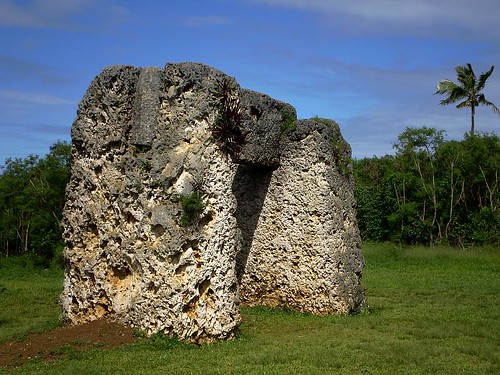 This week's podcast takes us back across the ocean to discover more of the sights, sounds and science of Tonga - see our previous episode for more on Tongan blowholes and whales.
This week's podcast takes us back across the ocean to discover more of the sights, sounds and science of Tonga - see our previous episode for more on Tongan blowholes and whales.On location in Tonga, we tackle the topics of:
- Haʻamonga ʻa Maui - otherwise known as The Stone Henge of the Pacific. This is an ancient 12-tonne stone trilithon whose purpose is not exactly known, much like that other Stone Henge in the UK. A previous King of Tonga, Tāufaʻāhau Tupou IV, once claimed it had an astronomical significance as it can determine the position of sunrise at solstices and equinoxes. As it was said by the King, it is the accepted explanation for what is an odd stone construction, at least in Tonga anyway.
- How did people get to Tonga in the first place? The generally accepted history is that the Lapita people came down through Papua New Guinea into Melanesia and Polynesia. However, Norwegian explorer Thor Heyerdahl had other ideas based on the fact that the sweet potato (kumera) is found in both South America and Polynesia. To prove that it was at least possible that Tongans came from South America, in 1947 he sailed the Kon-Tiki raft across the Pacific Ocean from Peru to Tuamotus. Heyerdahl showed that, by using only the materials and technologies available at the time, there were no technical issues that prevented South Americans coming to Polynesia. Whilst the evidence suggests that people came through South East Asia and Papua New Guinea to reach the Pacific, one school of thought suggests that Polynesians may indeed have travelled to South America and picked up the kumera from there.
And tacked onto the end of this show, we have a Correlation of the Week - this week discussing the relationship between eclipses and the stock market - see our previous story on the topic for more.
Listen to this podcast here:
Stay tuned for our final edition on Tonga in a few weeks.












likeyourpostrGamezhost
ReplyDeletebestopenworldgames2021
warzonebunker code
bestforgaming cpu
bestfivemsell
fivescriptfreecost
ReplyDeleteThank you so much for sharing this great blog.Very inspiring and
helpful too.Hope you continue to share more of your ideas.
I will definitely love to read.
Here's my website : -- 출장안마
(jk)
Physiotherapist in Pakistan
ReplyDeleteDiscover Coral, the Pacific's version of Stonehenge, and immerse yourself in Tonga's stunning sights, sounds, and scientific discoveries.I have no doubt that more research would advance the conversation.Thank you for dedicating your time to compose this content.I appreciate you drawing attention to this important matter.
ReplyDeleteA captivating glimpse into Tonga’s wonders! From the vibrant coral reefs to the mysterious “Stonehenge of the Pacific,” the article beautifully blends natural beauty, cultural heritage, and scientific insight. The vivid descriptions make you feel the sights and hear the sounds, sparking curiosity to explore this island paradise firsthand.
ReplyDeleteLift Dynamic
Episode 110 explores Tonga’s breathtaking reefs—coral formations dubbed the “Stonehenge of the Pacific”—revealing their geological mysteries and cultural significance. Journey through vibrant marine ecosystems, resonant traditional music, and scientific insights into ocean conservation. Discover how nature, history, and community intertwine across Tonga’s islands, where ancient stories meet living seas. Law Offices of SRIS, P.C.
ReplyDelete